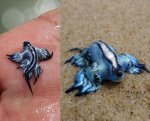Don't know if any of you have ever seen this but thought i would share. I just came across it when i was searching for something else. This has to be the coolest mollusk i have ever seen in my life! Still amazed by it! http://www.youtube.com/watch?v=5x5I3DvuqZo
Blue dragon mollusk!!! seriously awsome
- Thread starter Reefcube29
- Start date
Description
The normal size of this species is up to 3 cm.[3] It is silvery grey on its dorsal side and dark and pale blue ventrally. It has dark blue stripes along the edge of its foot. It has a tapering body which is flattened and has six appendages which branch out into rayed cerata.[4] Its radula bears serrated teeth on their blades.[5]
[edit] Distribution and habitat
This nudibranch is pelagic, and is distributed throughout the world's oceans, in temperate and tropical waters. Regions where this slug is found include the East and South Coast of South Africa, European waters, the east coast of Australia and Mozambique.[6] This species floats upside down on the surface tension of the ocean.
[edit] Life history and behavior
G. atlanticus preys on other, larger pelagic organisms: the dangerously venomous Portuguese Man o' War Physalia physalis; the by-the-wind-sailor Velella velella; the blue button Porpita porpita; and the violet snail, Janthina janthina. Occasionally, individual Glaucus become cannibals given the opportunity.
G. atlanticus is able to feed on P. physalis due to its immunity to the venomous nematocysts. The slug consumes the entire organism and appears to select and store the most venomous nematocysts for its own use. The venom is collected in specialized sacs (cnidosacs), on the tip of their cerata, the thin feather-like "fingers" on its body.[7] Because Glaucus concentrates the venom, it can produce a more powerful and deadly sting than the Man o' War upon which it feeds.[7]
With the aid of a gas-filled sac in its stomach, G. atlanticus floats at the surface. Due to the location of the gas sac, the sea swallow floats upside down. The upper surface, actually the foot (the underside in other snails), has either a blue or blue-white coloration. The true dorsal surface (downwards in G. atlanticus) is completely silver-grey. This coloration is an example of counter shading, which helps protect it from predators from below, sides, and above.
Glaucus is a hermaphrodite, containing both male and female reproductive organs. Unlike most nudibranchs, which mate with their right sides facing, sea swallows mate with ventral sides facing.[8] After mating, both animals produce egg strings.
The normal size of this species is up to 3 cm.[3] It is silvery grey on its dorsal side and dark and pale blue ventrally. It has dark blue stripes along the edge of its foot. It has a tapering body which is flattened and has six appendages which branch out into rayed cerata.[4] Its radula bears serrated teeth on their blades.[5]
[edit] Distribution and habitat
This nudibranch is pelagic, and is distributed throughout the world's oceans, in temperate and tropical waters. Regions where this slug is found include the East and South Coast of South Africa, European waters, the east coast of Australia and Mozambique.[6] This species floats upside down on the surface tension of the ocean.
[edit] Life history and behavior
G. atlanticus preys on other, larger pelagic organisms: the dangerously venomous Portuguese Man o' War Physalia physalis; the by-the-wind-sailor Velella velella; the blue button Porpita porpita; and the violet snail, Janthina janthina. Occasionally, individual Glaucus become cannibals given the opportunity.
G. atlanticus is able to feed on P. physalis due to its immunity to the venomous nematocysts. The slug consumes the entire organism and appears to select and store the most venomous nematocysts for its own use. The venom is collected in specialized sacs (cnidosacs), on the tip of their cerata, the thin feather-like "fingers" on its body.[7] Because Glaucus concentrates the venom, it can produce a more powerful and deadly sting than the Man o' War upon which it feeds.[7]
With the aid of a gas-filled sac in its stomach, G. atlanticus floats at the surface. Due to the location of the gas sac, the sea swallow floats upside down. The upper surface, actually the foot (the underside in other snails), has either a blue or blue-white coloration. The true dorsal surface (downwards in G. atlanticus) is completely silver-grey. This coloration is an example of counter shading, which helps protect it from predators from below, sides, and above.
Glaucus is a hermaphrodite, containing both male and female reproductive organs. Unlike most nudibranchs, which mate with their right sides facing, sea swallows mate with ventral sides facing.[8] After mating, both animals produce egg strings.


